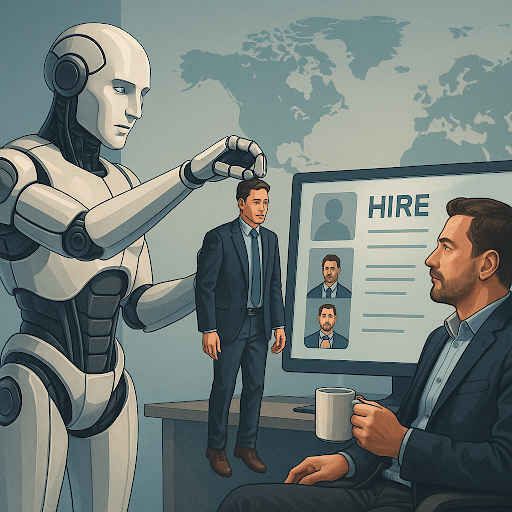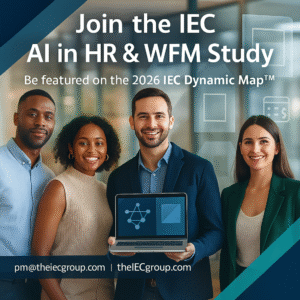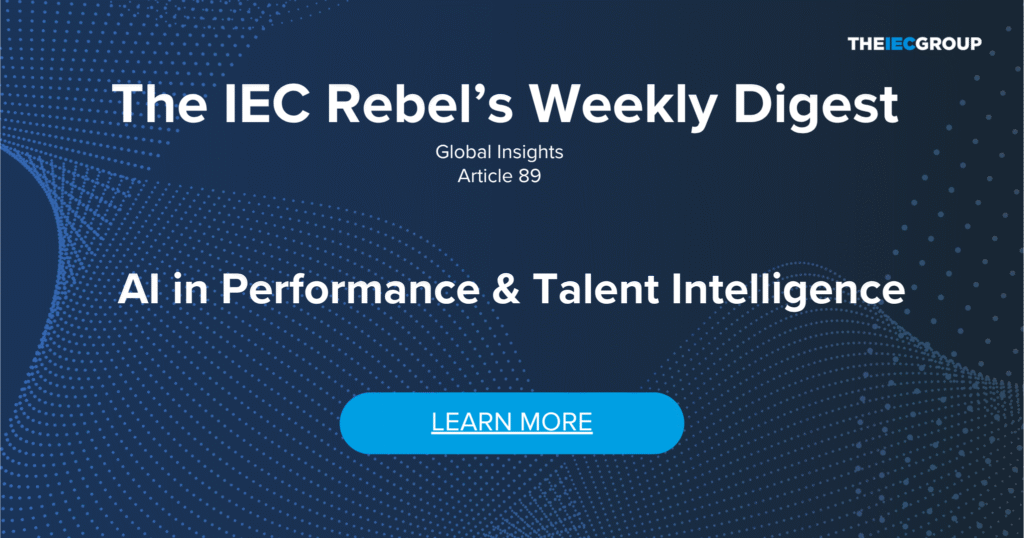AI in Performance & Talent Intelligence
Executive Summary
 AI is rapidly transforming talent acquisition—from how we source candidates to how we screen, engage, and measure quality of hire. But let’s be clear: this is not about machines taking over recruiting. It’s about amplifying human intelligence. The future of hiring belongs to organizations that combine AI precision with human empathy, context, and judgment.
AI is rapidly transforming talent acquisition—from how we source candidates to how we screen, engage, and measure quality of hire. But let’s be clear: this is not about machines taking over recruiting. It’s about amplifying human intelligence. The future of hiring belongs to organizations that combine AI precision with human empathy, context, and judgment.
Our latest IEC Rebel’s Digest section on AI-Driven Talent Acquisition dives deep into how leading companies are redesigning their hiring funnels around data, governance, and human-in-the-loop decision-making. We explore the tools, architectures, and measurable outcomes that are redefining speed, fairness, and candidate experience—without losing the personal touch that makes recruitment meaningful.
You’ll find practical playbooks for CHROs, recruiters, and HR tech providers, plus the maturity models and governance standards shaping tomorrow’s AI-enabled HR landscape.
This article is also a preview of one of the three categories of the first global IEC study on “AI in Talent Management and Development”, which will benchmark the world’s most advanced providers.
Vendors and HR leaders alike are invited to participate free of charge and help define what responsible, human-centered AI in HR truly looks like.
Join the study today and be part of shaping the future of intelligent, ethical hiring.
The short of it
Performance management is finally getting the brain it always pretended to have. AI is turning backward-looking, form-filling rituals into a living “Talent OS” that maps skills, predicts impact, and nudges better decisions in the flow of work. The winners won’t be the flashiest chatbots; they’ll be the platforms with clean data contracts, explainable models, and opinionated workflows that managers and employees actually use.
What this category covers (and what it doesn’t)
This piece focuses on Performance & Talent Intelligence—the layer that senses, interprets, and acts on human capital signals across your HR tech stack. It spans:
- Performance: goals/OKRs, feedback, reviews, calibration, compensation inputs.
- Talent Intelligence: skills/role graphs, potential and readiness signals, internal mobility, succession, and workforce planning.
It doesn’t cover recruiting/sourcing AI or learning content generation in depth—those are addressed in the other categories of the study.
Why now: the three forces that made this possible
- Unified skills/role ontologies: HR suites and specialist vendors now maintain live skills graphs that sync with job architectures, career frameworks, and learning catalogs.
- Multimodal signals: Work patterns, project metadata, peer feedback, code commits, sales activity, customer tickets—these operational breadcrumbs can be joined (ethically) to triangulate real impact.
- Generative interfaces with memory: Copilots sit inside performance cycles, translate strategy into measurable goals, summarize evidence, draft narratives, and illuminate trade-offs during calibration.
How HR actually uses it (today, not someday)
Think of your HR org as the portfolio manager of talent investments. This category helps you:
- Translate strategy to skills and goals: AI maps company priorities → team outcomes → individual OKRs, proposing measurable key results and linking them to skill growth opportunities.
- Run bias-aware, evidence-rich check-ins: Copilots compile achievements, peer feedback, and outcome metrics into concise updates—flagging missing evidence and suggesting coaching prompts.
- Calibrate with telemetry, not folklore: During calibration, models surface distribution anomalies, detect rating inflation, and simulate comp scenarios under fairness constraints.
- Unlock mobility and succession: Talent intelligence suggests internal candidates for roles and projects based on adjacent skills and proven outcomes, not just manager reputation.
- Instrument development: AI recommends targeted learning tied to gaps blocking goal attainment; it tracks skill gain from real work (not just course completion).
- Prove ROI: HR and Finance get common dashboards on productivity, quality, ramp time, regrettable attrition, and the skill pipeline feeding strategic initiatives.
How the work changes (for everyone)
For HR Business Partners: | From “calendar shepherds” to portfolio stewards: you’ll manage talent bets, scenario modeling, risk alerts, and outcome attribution. Meetings shift from status to decision. |
For People Leaders: | From episodic reviews to always-on coaching: leaders get nudges—“Your team’s goal drift is 18% this month; here are 3 conversations to unblock it”—plus evidence-backed narratives. |
For Employees: | From black-box ratings to a personal Talent OS: clear goals, skill pathways, recommended projects/mentors, and achievement digests pre-assembled from work systems. |
For Finance & Comp: | From historical averages to fairness-controlled simulation: comp budgets optimized against performance distributions, pay equity targets, and retention risk. |
Core capabilities: what “good” looks like
- Skills & Role Graph
- Live ontology mapped to job architecture, levels, and career paths.
- Skill inference from work artifacts (commits, tickets, sales notes) with human verification.
- Adjacency modeling (what can this person do next with minimal ramp).
- Goal/Outcome Orchestration
- AI-assisted OKR creation (SMART by design), traceability to company priorities.
- Evidence binding: link goals to systems of record (CRM, code repos, CX tools).
- Performance Copilot
- Drafts self-reviews and manager summaries with citations to evidence.
- Insight prompts: blind-spot detection, feedback quality checks, coaching suggestions.
- Calibration Intelligence
- Fairness analytics: rating variance by function/level/gender; confidence intervals.
- Scenario planning: see pay and distribution impacts before you lock the slate.
- Mobility & Succession
- Opportunity matching: near-adjacent roles/projects; readiness scores with explanations.
- Bench strength views and risk heatmaps (key roles vs. coverage).
- Development Engine
- Gap-driven learning and stretch assignment recommendations.
- Skill growth attribution: learning → project → measured outcome.
- Trust, Risk & Controls
- Explainability (why this recommendation), audit logs, consent flows, data minimization.
- Regional controls (e.g., turn off modalities that breach local norms/regulations).
Benefits you can actually measure
- Cycle time: 30–50% reduction in review/admin hours due to drafting/summarization.
- Quality of signal: more evidence-backed feedback and fewer “halo/horns” artifacts.
- Fairness: reduced variance and bias indicators across teams/levels.
- Internal mobility: higher fill rates from inside; faster time-to-productivity for movers.
- Retention: lower regrettable attrition in high-impact roles—because growth paths are visible.
- Skill velocity: shorter time from gap identification to demonstrated application.
(Your baselines matter. Start measuring before you deploy; see the metrics section below.)
What to avoid (red lines & realism)
- Emotion or personality inference from video/voice: high risk, low validity; often non-compliant.
- Covert surveillance (keystroke, screen scraping, mic/cam activation): kills trust; legally fraught.
- Model sprawl: five copilots with no shared memory equals confusion and contradictory suggestions.
- Over-indexing on proxies: activity ≠ impact. Tie signals to outcomes, not busyness.
How providers differentiate (the real trenches)
1) Graph-First vs. Workflow-First
- Graph-First specialists lead with deep skills ontologies, strong inference, and mobility intelligence.
- Workflow-First suites differentiate by embedding copilots inside goals, check-ins, and comp—less flashy graphs, more adoption.
2) Model Strategy
- Orchestrators blend multiple frontier and open models via routing and RAG (retrieval-augmented generation). Pros: flexibility and cost control.
- Proprietary-leaning vendors fine-tune domain models for skills inference and calibration. Pros: tight performance; Cons: lock-in risk.
3) Evidence & Explainability
- High-trust platforms show citations (which CRM opportunity, which repo commit), confidence scores, and counterfactuals (“rating would change if X evidence were present”).
- Low-trust tools output pretty narratives with no receipts.
4) Data Contracts & Governance
- Mature vendors give data contracts: clear schemas, lineage, retention, region pinning, and admin guardrails.
- Others toss a security whitepaper and call it a day.
5) Edge-to-Core Integration
- Leaders plug into work systems (Git, Jira, Salesforce, Zendesk, ServiceNow, contact center) not just HCM.
- Laggards rely solely on self-reported forms and periodic HRIS syncs.
6) Guardrails & Regionalization
- Strong players ship granular controls: which signals are allowed, who can see what, when data purges; plus region-aware defaults (e.g., Germany works council-safe settings).
- Weak players offer one global switch: “on/off.”
7) Outcome Attribution
- Top vendors attempt causal links: learning → project → metric movement.
- Others stop at skill badges and course completions.
Architecture patterns you should expect
- RAG over an enterprise talent lakehouse: profiles, skills graph, goals, feedback, project metadata, and outcome metrics indexed for retrieval during drafting and calibration.
- Event-driven pipelines: stream changes from work tools; avoid end-of-quarter data dumps.
- Human-in-the-loop checkpoints**: managers validate skill inferences; reviewers confirm evidence; comp committees approve scenario picks.
- Privacy-by-design: purposeful collection, least privilege access, encryption at rest/in transit, regional residency, automated retention windows.
Implementation playbook (90 days to value)
Weeks 0–2 — Foundation
- Choose one pilot population (e.g., Product & CX, ~200–500 people).
- Lock a data contract: which systems of record feed evidence; what’s in/out; retention.
- Publish the red-lines policy to employees and works councils.
Weeks 3–6 — Wiring + Guardrails
- Import job architecture and initial skills framework; enable skill inference with manager verification.
- Integrate at least two work systems (e.g., GitHub + Jira, or Salesforce + Zendesk).
- Configure explainability panels and audit logs. Turn off high-risk modalities by default.
Weeks 7–10 — Copilot in the flow
- Launch AI-assisted OKRs and check-in summaries with citations.
- Run micro-training for managers on evidence-based feedback and bias prompts.
- Begin mobility suggestions for 1–2 critical roles only.
Weeks 11–13 — Calibration Intelligence
- Use fairness dashboards during mid-cycle calibration; simulate 2–3 comp scenarios.
- Publish a short results memo with before/after metrics and employee sentiment.
Metrics that matter (track these from day one)
- Admin time saved per manager per cycle.
- Evidence coverage: % of goals with bound outcome signals; % of review summaries with citations.
- Fairness indicators: rating variance, calibration drift, and comp deltas by cohort.
- Internal fill rate for target roles; time-to-productivity after internal moves.
- Skill velocity: time from identified gap → verified proficiency on the job.
- Retention: regrettable attrition in roles tagged as high strategic impact.
Buying guide: questions that separate signal from noise
- Evidence or opinion? Show me a review summary with citations to work systems.
- Explainability depth? Can a manager see why a readiness score moved, and what would change it?
- Guardrails? Can we region-restrict signals (e.g., no keystroke/biometric inputs) and set retention by data type?
- Data contract? Provide the schema, lineage, and purge workflows—before we sign.
- Ontology ops? How do you version skills/roles, merge duplicates, and handle adjacencies?
- Human-in-the-loop? Where and how do we approve inferences or override recommendations?
- Integration reality? Which connectors run event-driven (not batch), and what fields are actually mapped?
- Outcome attribution? Show a live example of learning → project → metric shift.
- Model strategy? Which foundation models, routing logic, and fallback plans do you use?
- Total cost to value? All-in services estimate to get our first 500 users productive in 90 days.
Maturity model (where are you today?)
Level 0 — Manual & Memory-Based
Forms, folklore, and calendar bloat. No shared ontology.
Level 1 — Assisted
AI drafts goals and summaries; skills tagged manually; limited evidence bindings.
Level 2 — Instrumented
Signals flow from work systems; explainable calibration; internal mobility suggestions active.
Level 3 — Portfolio-Driven
Causal attribution, comp simulations with fairness controls, workforce plans tied to strategy and skill supply.
Risks & governance (so you don’t burn trust)
- Bias & validity: measure disparate impact, but also test construct validity (are we measuring what matters?).
- Consent & transparency: plain-language notices, opt-outs where required, and visibility into personal data used.
- Data residency & works councils: default to local storage where necessary; co-design pilots with employee representatives.
- Kill switch: ability to disable a feature or input class instantly if concerns arise.
The near future (12–24 months)
- Skills → Outcomes closed loop: automatic detection of skill application in real work, feeding back into capability maps and pay bands.
- Org-graph reasoning: models that understand teams, dependencies, and social capital—helpful for succession and change planning.
- Companion agents for teams: squad-level copilots monitoring shared goals, surfacing risks, and coordinating development sprints.
- Causal & synthetic experimentation: more robust methods to separate correlation from contribution when attributing performance.
- Standards and attestations: customers demand model cards, data lineage attestations, and audit-ready logs as table stakes.
Rebel’s cheat-sheet (TL;DR you can act on)
- Start where signals exist (Product, Sales, CX); wire them into goals and reviews.
- Demand evidence-backed summaries and explainable scores; no receipts = no trust.
- Keep a published red-lines policy and regional guardrails; earn your social license to operate.
- Track five metrics from day one: admin time, evidence coverage, fairness deltas, internal fill rate, skill velocity.
- Choose vendors the way Finance picks ERPs: on data contracts, not demos.
Final take
AI won’t fix a broken performance culture—but it will instrument it. The real upgrade is managerial: fewer opinions, more outcomes; fewer forms, more coaching; fewer cycles, more flow. Build your Talent OS on clean signals, enforceable guardrails, and ruthless explainability. That’s how Performance & Talent Intelligence stops being theater and starts compounding into advantage.
Closing note & invitation
 Provider comparisons—and the identification of the leading AI provider in Talent Acquisition—will be a core part of the first global IEC study on “AI in Talent Management and Development.” Participants are invited to join free of charge.
Provider comparisons—and the identification of the leading AI provider in Talent Acquisition—will be a core part of the first global IEC study on “AI in Talent Management and Development.” Participants are invited to join free of charge.
Participation: pm@theIECgroup.com
Study scope (AI-first lens):
Study #1: AI in Talent Intelligence & Development
- AI-Driven Talent Acquisition
- Performance & Talent Intelligence
- Learning & Development (incl. internal mobility/marketplaces)
Study #2: AI in Workforce Operations & Pay
- AI in Scheduling & Time Management
- AI for Payroll & Compliance
- Total Workforce Orchestration (VMS/FMS, contractors, EOR)
Study #3: Employee Experience & People Insights
- Employee Experience & Virtual Assistants
- Workforce Analytics & Planning
Over the next few weeks, we’ll zoom into each of the eight categories in IEC Rebel’s Digest—one deep dive at a time, with practical use cases, KPIs, and the vendor patterns to watch.
IEC Rebel’s Digest— The IEC Group can help you audit your global employment setup by identifying labor leasing risks, verifying licensing requirements, and ensuring your EOR partners meet every compliance standard—before regulators come knocking.
Last but not Least: If you’re facing challenges and wondering how others are managing similar issues, why not join The Leadership Collective Community? It’s a peer group and webcast platform designed for leaders to exchange insights and experiences.
Introducing the IEC Knowledge Network Free Membership – Your Gateway to Seamless Access!
We are thrilled to present a new service that goes beyond the ordinary download experience. In addition to offering you the ability to download the things you love, we are delighted to introduce the IEC Knowledge Network Free Membership.
The Free Membership option grants you access to our library of articles and videos, without the need for tedious registrations for each piece of content.
The publication serves as a trusted resource to support executives in their pursuit of sustainable and successful global expansion. In addition the IEC Practitioners are available to discuss your specific challenge in more detail and to give you clear advise..
Take advantage of this valuable resource to accelerate your global expansion journey


